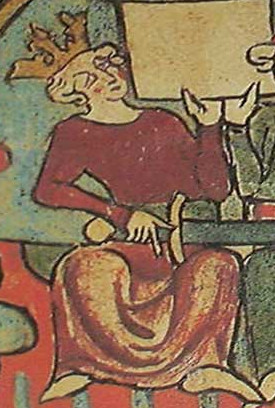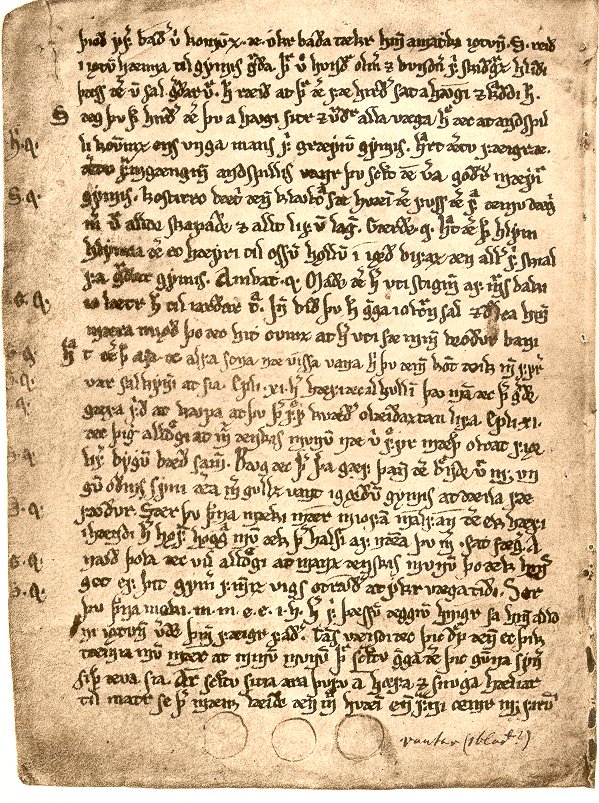|
Klári Saga
''Klári saga'' is one of the chivalric sagas of medieval Norway. Ostensibly derived from a Latin poem which Jón Halldórsson, Bishop of Skálholt, found in France, it became a prototype of the maiden king medieval Icelandic bridal-quest romances: it seems to have been the earliest of these, and was followed by many more. These include '' Nitida saga'', which is thought to be a direct response to ''Klári saga''. Content and themes The protagonist of the story, Prince Klárus of Saxony, is told of the fair princess Serena of France by his mentor, Perus. Smitten by the description, Klárus asks leave to travel to France and ask the hand of Serena. Perus initially advises Klárus to rethink his proposal, as Serena is prone tricks and deceits. Klárus does not listen however, and travels to France with his troops. Klárus presents himself to the king of France, and is welcomed as a guest of honor. After sending her maid down to examine Klárus, Serena invites him and his troops ... [...More Info...] [...Related Items...] OR: [Wikipedia] [Google] [Baidu] |
Chivalric Sagas
The ''riddarasögur'' (literally 'sagas of knights', also known in English as 'chivalric sagas', 'romance-sagas', 'knights' sagas', 'sagas of chivalry') are Norse prose sagas of the romance genre. Starting in the thirteenth century with Norse translations of French '' chansons de geste'' and Latin romances and histories, the genre expanded in Iceland to indigenous creations in a similar style. While the ''riddarasögur'' were widely read in Iceland for many centuries they have traditionally been regarded as popular literature inferior in artistic quality to the Icelanders' sagas and other indigenous genres. Receiving little attention from scholars of Old Norse literature, many remain untranslated. The production of chivalric sagas in Scandinavia was focused on Norway in the thirteenth century and then Iceland in the fourteenth. Vernacular Danish and Swedish romances came to prominence rather later and were generally in verse; the most famous of these are the Eufemiavisorna, them ... [...More Info...] [...Related Items...] OR: [Wikipedia] [Google] [Baidu] |
Jón Halldórsson
Jón Halldórsson (c. 1275 – 2 February 1339, or Candlemas; Modern Icelandic: ) was a Roman Catholic clergyman, who became the bishop of Iceland (1322–1339). He served in the diocese of Skálholt. He grew up in Norway as a friar of the Dominican order and has been assumed to have been of Norwegian birth, though since his mother's name, Freygerðr, is unknown outside Iceland, he may in fact have been (half) Icelandic. He studied both theology in Paris and canon law in Bologna, and his learning is seen as remarkable in contemporary Icelandic sources; '' Laurentius saga'' has him as one of Iceland's two best Latinists at his time, as fluent in Latin as in his mother-tongue. He was elected bishop following Grímr Skútuson and consecrated on 1 August 1322 but did not arrive in Iceland until the following year. He was noted for bringing the Icelandic Church more closely into line with canon law and for his skill as a preacher and storyteller; the introduction to ''Klári saga'' c ... [...More Info...] [...Related Items...] OR: [Wikipedia] [Google] [Baidu] |
Diocese Of Skálholt
The Diocese of Skálholt ( is, Skálholtsbiskupa ) is a suffragan diocese of the Church of Iceland. It was the estate of the first bishop in Iceland, Isleifr Gizurarson, who became bishop in 1056. (Christianity had been formally adopted in 1000). His son, Gizurr, donated it to become the official see. The Diocese was amalgamated in 1801 and now forms part of the Diocese of Iceland under the leadership of the Bishop of Iceland. In 1909 the diocese was restored as a suffragan see, with the Bishop of Skálholt being a suffragan bishop to the Bishop of Iceland. Roman Catholic * 1056–1080: Ísleifur Gissurarson * 1082–1118: Gissur Ísleifsson * 1118–1133: Þorlákur Runólfsson * 1134–1148: Magnús Einarsson * 1152–1176: Klængur Þorsteinsson * 1178–1193: St. Þorlákur helgi Þórhallsson * 1195–1211: Páll Jónsson * 1216–1237: Magnús Gissurarson * 1238–1268: Sigvarður Þéttmarsson (Norwegian) * 1269–1298: Árni Þorláksson * 1304–1320: Árni Helgaso ... [...More Info...] [...Related Items...] OR: [Wikipedia] [Google] [Baidu] |
Maiden King
Virginity is the state of a person who has never engaged in sexual intercourse. The term ''virgin'' originally only referred to sexually inexperienced women, but has evolved to encompass a range of definitions, as found in traditional, modern and ethical concepts. Heterosexual individuals may or may not consider loss of virginity to occur only through penile-vaginal penetration, while people of other sexual orientations often include oral sex, anal sex, or mutual masturbation in their definitions of losing one's virginity. There are cultural and religious traditions that place special value and significance on this state, predominantly towards unmarried females, associated with notions of personal purity, honor, and worth. Like chastity, the concept of virginity has traditionally involved sexual abstinence. The concept of virginity usually involves moral or religious issues and can have consequences in terms of social status and in interpersonal relationships.See her anpages 47 ... [...More Info...] [...Related Items...] OR: [Wikipedia] [Google] [Baidu] |
Nitida Saga
''Nitida saga'' (medieval manuscript spelling) or ''Nítíða saga'' (normalised Old Norse and modern Icelandic spelling) is a fictional late medieval Icelandic Chivalric sagas, romance saga thought to have been composed in Iceland in the fourteenth century. This saga is about a maiden-king named Nitida, who rules over France, and who is pursued by kings and princes from such faraway places as Constantinople, India, and a place the saga calls the Land of the Saracens. It is thought to be a direct response to ''Klári saga'': in ''Klári saga'', the main female protagonist, Serena, is brutally punished for her initial refusal to marry the hero Klárus, whereas the heroine of ''Nitida saga'' is portrayed much more favourably. Ethnicity, travel, and geography play important roles in the saga, and questions of gender and power, while magic, trickery, and deception are also prominent. Summary In the words of Sheryl McDonald Werronen, The romance begins by describing the maiden-king N� ... [...More Info...] [...Related Items...] OR: [Wikipedia] [Google] [Baidu] |
Régis Boyer
Régis Boyer (25 June 1932 – 16 June 2017) was a French literary scholar, historian and translator, specialised on Nordic literature and the Viking Age. Biography Régis Boyer was born in Reims on 25 June 1932. At age 20 he earned a degree in literature from the Nancy University, where he became interested in Scandinavian culture during a course held by Maurice Gravier. He served in the Algerian War for 15 months before resuming his studies. He took an ''agrégation'' in modern literature in 1959, after which he left France to teach French literature at the University of Łódź (1959–1961), Reykjavík University (1961–1963), Lund University (1963–1964) and Uppsala University (1964–1970). In 1970 he returned to France to obtain his doctorate and to teach at the Paris-Sorbonne University, where he became a professor of Scandinavian languages, literature and civilisation and served as director of the Institute of Scandinavian Studies until his retirement in 2001. He was know ... [...More Info...] [...Related Items...] OR: [Wikipedia] [Google] [Baidu] |
Exemplum
An exemplum (Latin for "example", pl. exempla, ''exempli gratia'' = "for example", abbr.: ''e.g.'') is a moral anecdote, brief or extended, real or fictitious, used to illustrate a point. The word is also used to express an action performed by another and used as an example or model. Exemplary literature This genre sprang from the above, in classical, medieval and Renaissance literature, consisting of lives of famous figures, and using these (by emphasizing good or bad character traits) to make a moral point. Collections of Exempla helped medieval preachers to adorn their sermons, to emphasize moral conclusions or illustrate a point of doctrine. The subject matter could be taken from fables, folktales, legends, real history, or natural history. Jacques de Vitry's book of exempla, c. 1200, Nicholas Bozon's ''Les contes moralisés'' (after 1320), and Odo of Cheriton's ''Parabolae'' (after 1225) were famous medieval collections aimed particularly at preachers. Geoffrey Chaucer's '' ... [...More Info...] [...Related Items...] OR: [Wikipedia] [Google] [Baidu] |
Low German
: : : : : (70,000) (30,000) (8,000) , familycolor = Indo-European , fam2 = Germanic , fam3 = West Germanic , fam4 = North Sea Germanic , ancestor = Old Saxon , ancestor2 = Middle Low German , dia1 = West Low German , dia2 = East Low German , iso2 = nds , iso3 = nds , iso3comment = (Dutch varieties and Westphalian have separate codes) , lingua = 52-ACB , map = Nds Spraakrebeet na1945.svg , mapcaption = Present day Low German language area in Europe. , glotto = lowg1239 , glottoname = Low German , notice = IPA Low German or Low Saxon (in the language itself: , and other names; german: Plattdeutsch, ) is a West Germanic language variety spoken mainly in Northern Germany and the northeastern part of the Netherlands. The dialect of Plautdietsch is also spoken in the Russian Mennonite diaspora worldwi ... [...More Info...] [...Related Items...] OR: [Wikipedia] [Google] [Baidu] |
Chivalric Sagas
The ''riddarasögur'' (literally 'sagas of knights', also known in English as 'chivalric sagas', 'romance-sagas', 'knights' sagas', 'sagas of chivalry') are Norse prose sagas of the romance genre. Starting in the thirteenth century with Norse translations of French '' chansons de geste'' and Latin romances and histories, the genre expanded in Iceland to indigenous creations in a similar style. While the ''riddarasögur'' were widely read in Iceland for many centuries they have traditionally been regarded as popular literature inferior in artistic quality to the Icelanders' sagas and other indigenous genres. Receiving little attention from scholars of Old Norse literature, many remain untranslated. The production of chivalric sagas in Scandinavia was focused on Norway in the thirteenth century and then Iceland in the fourteenth. Vernacular Danish and Swedish romances came to prominence rather later and were generally in verse; the most famous of these are the Eufemiavisorna, them ... [...More Info...] [...Related Items...] OR: [Wikipedia] [Google] [Baidu] |
Icelandic Literature
Icelandic literature refers to literature written in Iceland or by Icelandic people. It is best known for the sagas written in medieval times, starting in the 13th century. As Icelandic and Old Norse are almost the same, and because Icelandic works constitute most of Old Norse literature, Old Norse literature is often wrongly considered a subset of Icelandic literature. However, works by Norwegians are present in the standard reader ''Sýnisbók íslenzkra bókmennta til miðrar átjándu aldar'', compiled by Sigurður Nordal on the grounds that the language was the same. Early Icelandic literature The medieval Icelandic literature is usually divided into three parts: *Eddic poetry *Sagas *Skaldic poetry The ''Eddas'' There has been some discussion on the probable etymology of the term "Edda". Most say it stems from the Old Norse term ''edda'', which means great-grandmother, but some see a reference to Oddi, a place where Snorri Sturluson Snorri Sturluson ( ; ; 1179 – 22 S ... [...More Info...] [...Related Items...] OR: [Wikipedia] [Google] [Baidu] |
Sagas
is a series of science fantasy role-playing video games by Square Enix. The series originated on the Game Boy in 1989 as the creation of Akitoshi Kawazu at Square. It has since continued across multiple platforms, from the Super NES to the PlayStation 2. The series is notable for its emphasis on open world exploration, non-linear branching plots, and occasionally unconventional gameplay. This distinguishes the games from most of Square's other franchises. Development The ''SaGa'' series was created by game designer Akitoshi Kawazu, whose contributions prior to the franchise's introduction include ''Final Fantasy'' and ''Final Fantasy II''. At a time when Nintendo's Game Boy was becoming popular worldwide due to the puzzle game ''Tetris'', then-Square president Masashi Miyamoto requested that a development team create a game for the handheld console. Kawazu and fellow designer Koichi Ishii suggested that the company develop a role-playing video game, thus making ''Makai Tou ... [...More Info...] [...Related Items...] OR: [Wikipedia] [Google] [Baidu] |

_-Youth_(1893).jpg)


